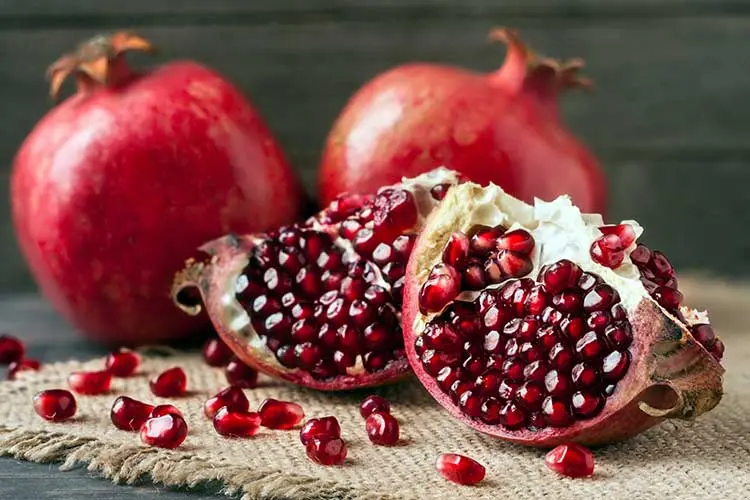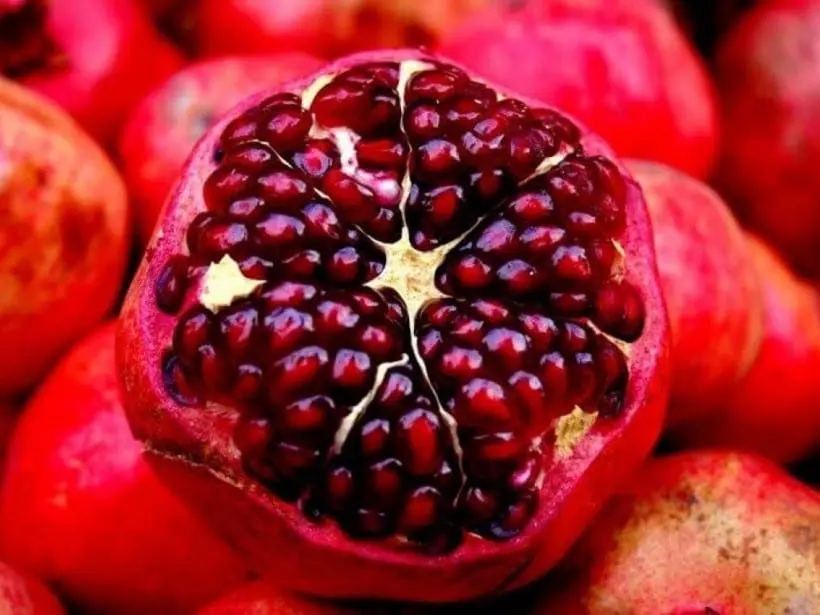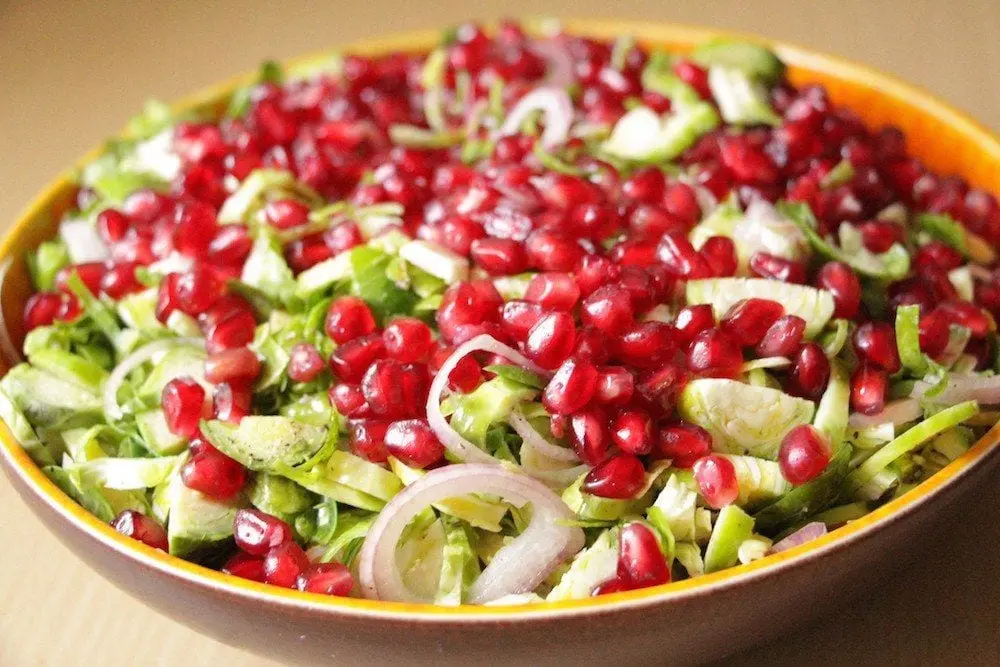Contents
Description
Pomegranate is a shrub or tree up to 6 meters high. The fruits are large, red and spherical, separated by membranes inside, between which there are grains surrounded by pulp. A ripe pomegranate can contain more than a thousand seeds.
History of the pomegranate
In ancient times, pomegranate was considered a symbol of fertility and a remedy for infertility. The word “pomegranate” is translated from Latin as “grainy”, which is explained by its structure.
The homeland of the pomegranate is North Africa and Central Asia. Now this plant is grown in all countries with a subtropical climate.
Dyes for fabrics are made from pomegranate flowers, as they contain a bright red pigment. The crusts are used for various medicinal decoctions.
In ancient times, it was called the Punic, Carthaginian or pomegranate apple because of the similarity in shape and color. Some believe that the pomegranate was the very forbidden fruit with which Eve was tempted.
Composition and calorie content of pomegranate

Pomegranate contains about 15 amino acids, five of which are irreplaceable. Also, pomegranate is rich in vitamins K, C, B9 and B6 and minerals (potassium, copper, phosphorus). Moreover, pomegranate is a low-calorie fruit. There are only 72 kilocalories in 100 grams.
- Caloric content 72 kcal
- Proteins 0.7 g
- Fat 0.6 g
- Carbohydrates 14.5 g
The benefits of pomegranate
Pomegranate grains contain many vitamins: C, B6, B12, R. The concentration of microelements is also high: calcium, magnesium, potassium, manganese, phosphorus, iodine, iron, sodium.
Pomegranate juice is saturated with vegetable acids: citric, malic, tartaric, oxalic, amber. Thanks to them, this fruit stimulates the appetite and helps digestion with low stomach acidity.
Pomegranate is useful for the cardiovascular system: it strengthens blood vessels, normalizes blood pressure, promotes hematopoiesis, active synthesis of hemoglobin and erythrocytes. Therefore, pomegranate juice is often prescribed for B12 anemia, low hemoglobin and general weakness during the recovery period after illness and surgery. Useful for all elderly people as prevention of heart and vascular diseases.
Pomegranate harm

Small amounts of grains will not harm, but you should be careful with undiluted juice. Pomegranate juice is contraindicated for peptic ulcer and gastritis with high acidity. You can drink it only diluted, since it is very acidic and can irritate the mucous membranes – for the same reason, juice should not be given to young children.
After taking the juice, you should rinse your mouth, otherwise it eats away the tooth enamel. Pomegranate can be fixed, so it should be limited to people with constipation. Sometimes medicinal decoctions are made from the peel or bark of pomegranate and you cannot get carried away with them. After all, the pomegranate peel contains poisonous alkaloids.
The use of pomegranate in medicine
In medicine, almost all parts of the plant are used: peel, flowers, bark, bones, pulp. They make various preparations, tinctures and decoctions for the treatment of anemia, diarrhea and inflammatory diseases of the skin and mucous membranes.
The white bridges that are inside the fruit are dried and added to hot vegetable infusions. It helps to balance the nervous system and relieve insomnia.
From the bones, substances are extracted that have anti-inflammatory properties, as well as stimulating intestinal peristalsis. Also, pomegranate oil is obtained from the seeds, which is rich in vitamins F and E. They promote rejuvenation and are a preventive agent against cancer. This makes it possible to recommend this tool to people working in conditions of increased radiation.
Pomegranate juice is an effective prevention of scurvy, as it contains high concentration of vitamin C.
Pomegranate seeds are recommended to be included in the diet of hypertensive patients, since it helps to lower blood pressure. This fruit in general has a positive effect on the heart and blood vessels, as well as on blood formation.
Pomegranate juice can help with diarrhea, because it has fixing properties. For the same purpose, a decoction of the peel is used.

“Pomegranate is low in calories, so it can be used for dietary nutrition as well. However, it is worth remembering that it stimulates the appetite and the effect may be the opposite, ”warns Alexander Voinov.
Pomegranate juice contains many amino acids. Half of them are found only in meat. Therefore, pomegranate is indispensable in the diet of vegetarians.
Taste qualities
In addition to its unique nutritional value and appetizing appearance, pomegranate is also extremely tasty. Fresh fruit grains have a juicy sweet and sour taste with a slight astringent shade. The juice squeezed out of them is distinguished by its concentration, more pronounced taste and astringency.
Added to various dishes, pomegranate can add a pleasant sourness and beautify their appearance. Its combination with pepper in hot-sweet vegetable stews and sauces is especially relevant. The specific sour, slightly astringent taste of pomegranate adds a cooling note to spicy dishes. And its very delicate sweet and sour shade gives an original taste to marinades.
The ideal fruit is pomegranate for diabetics, who are prohibited from other sweet fruits (bananas, pears, strawberries, etc.). Its sweet and sour taste can be enjoyed without any harm to health and even slightly lower blood sugar levels. For those for whom pomegranate extract is not suitable in its pure form due to its high acidity, it is recommended to mix it with other juices, for example, carrot or beet juice, to soften the taste.
How to choose and store pomegranates

When choosing a pomegranate, you should pay attention to the peel. In a ripe fruit, the crust is slightly dry, hard and in places repeats the shape of the grains inside. If the skin is smooth and the petals are green, the pomegranate is unripe. Ripe pomegranates are usually large and heavy.
The soft pomegranate is clearly damaged in transit or frostbite, which negatively affects the shelf life and taste.
Pomegranates are one of the most suitable for long-term storage of fruits. They can lie for 10 or 12 months. The most ripe fruits are sold in November.
For long-term storage in a cool place (underground or refrigerator), the pomegranates should be wrapped in parchment to avoid evaporation of moisture from the fruit. Also, pomegranates can be frozen, whole or grains. At the same time, it practically does not lose its beneficial properties.
The use of pomegranate in cooking

Basically, pomegranate seeds are consumed fresh, added to various salads and desserts. But they also use grains and pomegranate juice for making fried, stewed and boiled dishes, jam and marshmallow. Pomegranate is versatile and goes well with both meat and sweet fruits.
In Caucasian cuisine, boiled pomegranate juice is prepared, which serves as a sauce for various dishes. Pomegranate seeds are dried and used as a vegetable seasoning in Indian and Pakistani cuisine. This spice is called anardana.
To quickly get the seeds out of the fruit, you need to cut off the “cap” of the fruit from above and below and make vertical cuts along the slices. While holding the fruit over a bowl, tap hard on the peel with a spoon and the grains will spill out.
Pomegranate and Chinese cabbage salad

This salad is suitable for dietary nutrition – it is low in calories and contains a lot of nutrients. Adding eggs increases the satiety and calorie content of the dish. Instead of chicken, you can use a couple of quail eggs.
Ingredients
- Pomegranate seeds – a handful
- Peking cabbage – 2-3 leaves
- Small chicken breast – 0.5 pcs
- Egg – 1 piece
- Parsley – a few twigs
- Olive oil, lemon juice – 1 tablespoon each
- Ground black pepper, salt – to taste
Boil skinless chicken breast in salted water. Boil a chicken egg. Cool and cut into cubes. Chop cabbage and herbs. In a bowl, combine oil, pepper, salt, lemon juice. Combine all ingredients in a salad bowl, season and stir.









